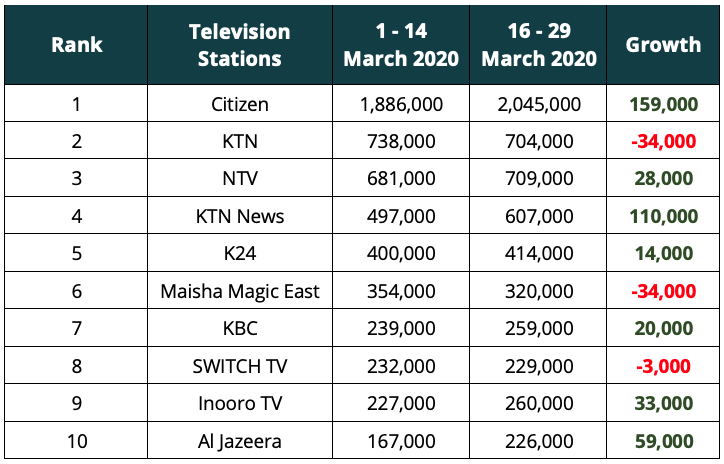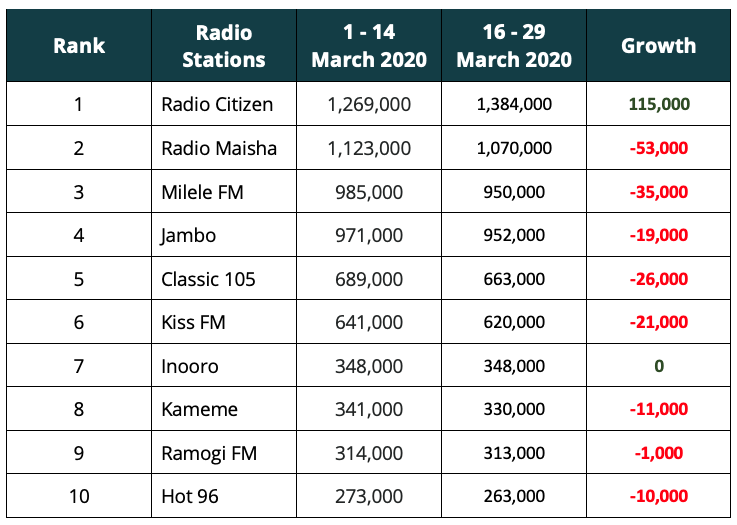The Government of Kenya (GoK) received confirmation of the first case of COVID-19 in Kenya on Friday, March 13th 2020. The Kenyan Government thus issued guidelines for citizens on actions to be taken in order to minimize the spread of the pathogen and prevent new infections. Amongst them, employers both in the private sector and in government were encouraged to allow staff to work from home starting 16th March 2020.
Since this time, GeoPoll has been working around the clock to bring quality data on COVID-19’s various impacts on people and professionals on a global scale. Our team of research experts did an analysis of GeoPoll’s audience measurement data comparing audience trends from before and after the government directive on handling the Coronavirus.
The analysis provides findings of overall media consumption from 1st – 29th March 2020. Data is specific to persons aged 15+ years old nationally, both males and females. The data analyzed was from 6 a.m. to 12 a.m. Additional analysis is available by specific times of the day and further by location and key demographics. Contact us today to discuss options for such additional data and analysis.
TV Viewership in Kenya, 6 a.m. – 12 a.m.
Average television viewership increased 335,000 viewers, from 6.76 million to 7.09 million, after GoK issued country-wide COVID-19 preventative measures. When the audience data is broken down by station, Citizen TV, KTN News, and Al Jazeera had the largest increases in viewership. Compared to the first 2 weeks of March 2020, Citizen TV’s viewership rose 159,000 viewers, KTN News’ viewership rose 110,000 viewers, and Al Jazeera’s viewership rose 59,000.
As viewership increased on Citizen TV, KTN News, and Al Jazeera, viewership decreased for other popular Kenyan television stations. Maisha Magic East, KTN, and Switch TV all had decreased viewership in the second half of March 2020. KTN Home and Maisha Magic East lost the most viewers with a 34,000 decrease each, whereas Switch TV followed with a lower decrease in viewers. GeoPoll’s research experts believe the shifts in viewership trends on television were driven by a fervor for news updates on COVID-19’s impact on Kenya and the larger global community.

Radio Listenership, 6am -12am
In contrast to what was seen in television viewership, average radio listenership in Kenya fell from the first half of March to the latter half of March. The available radio audience in the first 2 weeks of March 2020 was 10.79 million listeners. This listenership dropped down 66,000 listeners to 10.72 million on from 16th – 29th March. Despite this drop, radio still secures a few million more listeners on average than television secures viewers, regardless of the COVID-19 related shifts in consumption behavior.

From a granular view of the audience measurement data, it was observed that shifts in radio listenership tended to appear during specific times of the day. For example, listenership declined for a handful of the top stations from 6 a.m. to 8 a.m. after the COVID-19 stay-at-home protections were issued. Total average listenership then ramps up between 8 a.m. through about 2 p.m. before it declines again for the remainder of the day.
Despite these trends, it is important to emphasize that there are distinct variations by time block per each radio station. Some of the standout listenership audience variations include Radio Citizen, which recorded growth across most time blocks. Radio Jambo received a significant increase in listenership between noon and 2 p.m. and after 10 p.m. Classic 105, on the other hand, had significant peaks between 2 p.m. and 6 p.m. Naturally, each of the remaining stations studied had unique crests and troughs in listenership beyond what was seen as trends across the board.
GeoPoll’s research experts believe the shifts in radio audiences are being driven by a myriad of factors, of which we can only cover a few. First, with the clarion call for people to stay at home, consumers are starting off their days later than normal, which aligns with the decline in listenership from 6 a.m. to 8 a.m. Additionally, most radio stations broadcast news updates at the top of each hour, unlike social media and TV where news is relayed on a real-time basis as “breaking news”, which leaves radio news updates behind the curve for the most up-to-date news sources available. Lastly, our research experts believe because people are not on-the-go like they are in an average week, radio must compete with various other media channels and pass times that are not available to them on-the-go.
GeoPoll’s Ongoing Efforts
Altogether, with consumers spending more time at home, their listenership and viewership attention is being split across the traditional media of TV and radio, as well as other media platforms including social media, SVOD, VOD, gaming, etc. Seeing as the Government of Kenya has issued further directives of restricted movement, we anticipate a further increase in TV viewership and recognize that sustained dips in radio listenership are possible. As always, GeoPoll will continue collecting daily data on media consumption in Kenya and beyond. To learn more about GeoPoll’s audience measurement capabilities, contact us today.



